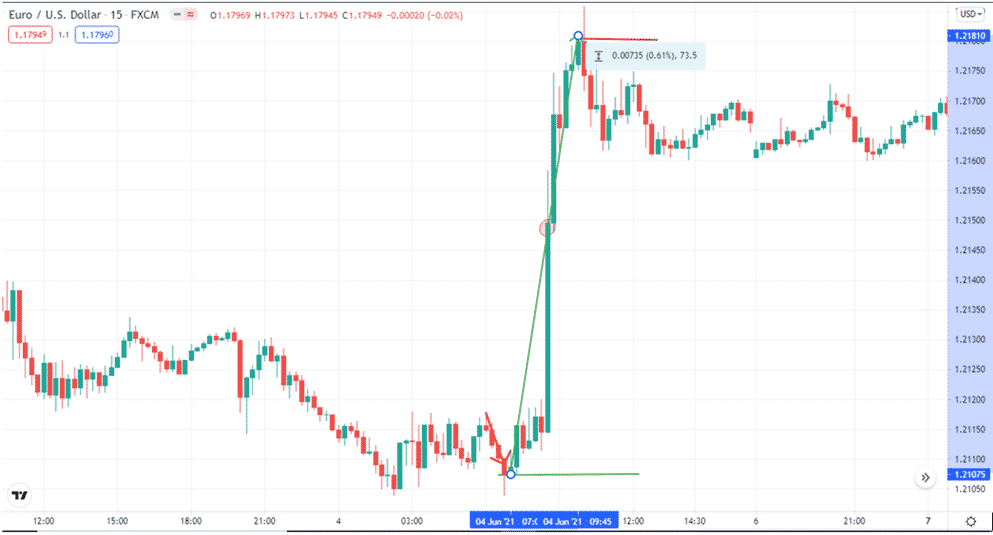Aside from Fed meetings and interest rate decisions, the Nonfarm Payrolls (NFP) report is one of the largest market movers on the Forex markets. The NFP data are among the most reliable barometers of economic performance.
The US Bureau of Labor Statistics publishes data on new job creation and other aspects of the labor market on the first Friday of every month. However, public sector workers, private homes, non-profits, and the farming business are not included in this dataset.
An analysis of the NFP shows how well the US labor market is doing as well as where it is headed. If the economy is performing poorly, employers will hire fewer new employees and may even have to let go of some current employees. Due to the fact that they no longer have money to spend, these people are unable to contribute to the economy because their income is reduced.
However, when the economy is doing well, companies recruit more employees. This means more people have money to spend, and in the end, it stimulates the economy. Increased spending then results in more companies realizing rising revenue, and they then hire even more workers.
Currencies affected by NFP
Because the NFP data is a data release based on the employment levels in the United States, it will have the greatest impact on currency pairs that feature the US dollar.
When the NFP is released, the volatility of other currency pairs rises as well, and traders should be mindful of this because they could be taken out of their positions.
Trading the NFP
The NFP report can be traded based on two different approaches: the long-term trend or recent news. The long-term approach to trading with the NFP is by far the most productive method of utilizing this tool. Essentially, you’re utilizing the NFP to spot trends, shifts in trends, and market turbulence before it happens. In other words, if the NFP is trending higher than its 12-month average, then the market’s underlying outlook is bullish.
In this scenario, it’s best just to pay attention to positive price chart signs. A price reversal or a pullback to a support level presents an excellent entry point for long-term traders. Longer-term style trades are those that you intend to hold for a number of days, if not weeks or months at a time.
If the NFP comes in better or worse than projected, confirms, or contradicts market expectations, then there is another way to trade the NFP. While this strategy does work, it doesn’t always create market-moving numbers because it doesn’t always get the market excited enough.
Things often become turbulent and chaotic during the actual NFP release. NFP releases typically elicit one of two price reactions:
- You’ll experience an increase in volatility right away.
- As more traders take in the numbers, the price trend reverses, and the price starts moving in the right direction.

In the case of the release shown on the chart above, the trade had a stop loss at 1.2107, just below the previous low. The profit was taken at 1.2115 at the close of the candle. This was a huge gamble, but it paid off as the trade returned 73 pips profit just before the market reversed.
If you’re going to trade the NFP, the best advice is to never make your decisions based on the actual NFP statistics. Trade based on what you think the market expects and how traders are likely to react to the data.
With three numbers to consider: last month’s number, expert forecasts, and actual numbers in the next NFP report, it’s easy to see why this is the most eagerly anticipated jobs report. There are three possible outcomes here, and the investors’ emotions are frequently determined by these three factors:
- It’s likely that the USD will rise if the actual amount comes in higher than expected or previously reported.
- If the reported figures turn out to be lower than expected and lower than the previous figures, the USD is likely to decline.
- A higher-than-expected but lower-than-previous figure suggests no clear direction and a lot of volatility. This leaves many investors confused.
Profit target
To determine where to put your target, consider the margin between the price following the NFP release and the opening price. This difference is then divided by two to give us the profit target. For instance, if the price moves by 100 pips initially, the profit target should be 50 pips.
Managing risk
Once you’ve determined your entry point, profit target, and stop-loss, you can calculate the amount of risk to take as well as the appropriate position size. To calculate your “trade risk,” subtract your stop loss from your entry price. Your profit potential will be obtained by subtracting the entry point from the profit target.
To avoid taking unnecessary risks, only trade if the reward potential is at least 1.5 times greater than the downside risk.
The size of your position is also crucial. Never put more than 1% of your money at risk in a single trade.
In summary
While the employment report is only one tool traders should use when assessing forex trading choices, its impact on the value of the US dollar and the ease with which it provides information make it a vital tool to utilize when analyzing forex trading opportunities.
